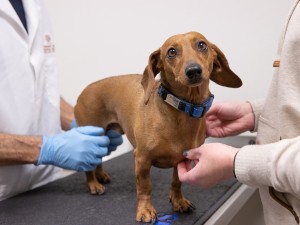Potential new non-surgical treatment may offer hope for small dogs with acute disc herniation
Many short-legged dogs suffer from herniated spinal discs, in which the disc ruptures and compresses or injures the spinal cord. This acute condition can lead to rear-end paralysis and incontinence. Conservative treatment is usually with strict cage rest, pain medication and physical therapy. If that doesn’t work, surgery to remove the disc is the only option. But that surgery is expensive and not everyone can afford it.
Now researchers at Texas A&M School of Veterinary Medicine & Biomedical Sciences (VMBS) are testing a non-surgical treatment that would be far more affordable. Rather than removing the affected disc, they inject an enzyme into the disc to dissolve it. The enzyme, called chondroitinase ABC, specifically attacks the disc contents without affecting surrounding tissue, including the spinal cord.
The first dog to receive the experimental treatment was a Dachshund named Oscar. Oscar had become suddenly paralyzed in his rear due to a herniated disc. His reglar veterinarian suggested surgery, but Oscar’s owner couldn’t afford it. His veterinarian had heard of a clinical trial at Texas A&M and Oscar was rushed there. The procedure involved anesthetizing Oscar and then inserting needles into his affected discs under the guidance of fluoroscopic x-rays. The enzyme was injected through the needles, and Oscar woke up in good spirits. Over the next several hours the enzyme dissolved the unwanted disc material, with no signs of discomfort from Oscar. Oscar’s spinal cord was still bruised and damaged from the herniation, so he still couldn’t walk until the cord gradually healed. But Oscar slowly started to walk again, and 20 days later he passed the standard test of being able to walk a 50-step distance without help. This is about the same recovery time it takes following surgery. By three months afterward, Oscar was running again.
Dr. Nick Jefferey, who heads the study, plans to perform the procedure on 30 dogs with herniated discs that can arrive at the Texas A & M Small Animal Hospital within 48 hours of losing the ability to walk. The dogs should be chondrodystrophic (generally those with short legs and long bodies such as Dachshunds) weighing less than 22 pounds and aged 18 months to 10 years old, with sudden onset inability to walk on their hindlegs associated with a presumed disc herniation. Dogs must be able to undergo anesthesia. More information about participating can be found at StudyPages – A potential new treatment for acute disc herniation in small breed dogs.
Short URL: http://caninechronicle.com/?p=257599
Comments are closed













